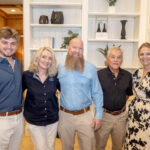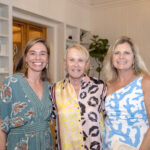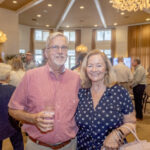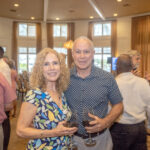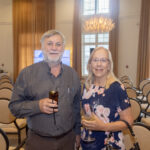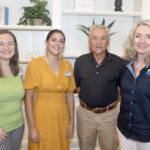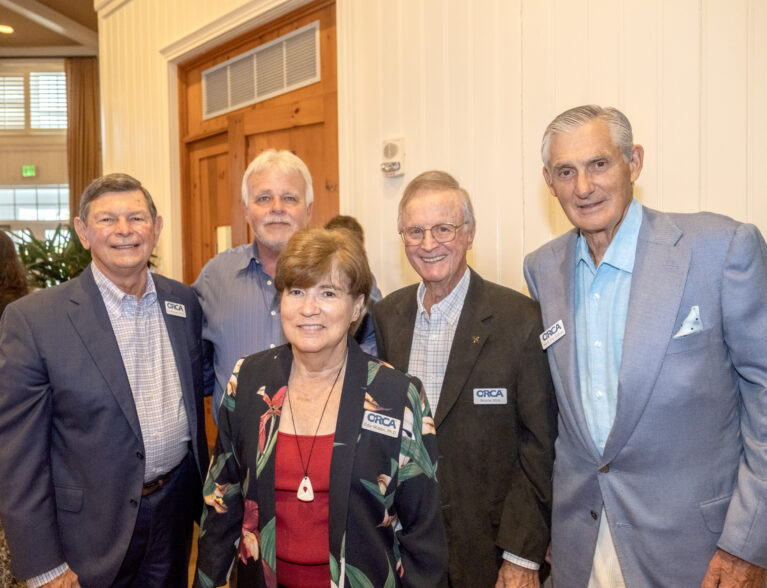
At a Donor Reception at the Quail Valley River Club, supporters of the Ocean Research and Conservation Association heard about recent accomplishments by the nonprofit, whose tagline is ‘mapping pollution and finding solutions.’
“Without you, we would not be here,” said board chairman Wayne Mills, applauding donors, fellow board members and ORCA staff.
“I am equally grateful to all of you for your support of ORCA. It has grown into something far beyond my wildest dreams,” said founder and CEO Edith “Edie” Widder, Ph.D.
Widder said she was excited to soon move into their new headquarters, the D.J. Rainone Research and Science Center in Vero Beach, reiterating thanks for their capital campaign contributions.
“Applied science is what we’re all about. We’re trying to use facts to drive change,” said Widder, adding that their work protects the vitality and natural beauty of the lagoon and, by extension, safeguards our health and economy.
Initiatives include their real-time Kilroy Technology Network, which monitors water quality and identifies areas of concern.
Through their Citizen Science program, said Missy Weiss, director of Citizen Science and Education, community members of all ages can volunteer to participate in real world science.
Volunteers can participate in four projects: Land to Sea Monitoring, Pollution Mapping, One Health Fish Monitoring, and A Day in the Life of the Indian River Lagoon.
Land to Sea projects improve water quality and biodiversity with Living Shorelines in-water restoration and Buffered Shorelines land-based restoration projects.
Volunteers plant and monitor native vegetation along shorelines, which act as physical and chemical barriers to rain runoff from yards, preventing grass clippings, pet waste, fertilizers, pesticides and sediments from entering canals, retention ponds and, ultimately, the lagoon.
With Pollution Mapping, volunteers take water and sediment samples at 28 locations in four counties, to be lab tested for toxins such as the herbicide glyphosate, which is persistently found in our water and sediments.
One Health Fish Monitoring assesses the types of pollutants entering the lagoon and their potential human risk. Volunteers assist in various ways; from donating fish they catch to extracting toxins in the lab.
“We look for biotoxins, heavy metals, herbicides like glyphosate, microplastics and something called forever chemicals, or PFAS,” said Weiss.
ORCA’s educational A Day in the Life of the Indian River Lagoon project is a way to get students interested in science and research.
One day each October, students of all ages collect samples at locations from Volusia to Palm Beach counties. On Oct. 5, more than 2,000 people, a record number, collected samples at 50 locations.
“And then luckily, because of some of the funders in this room, we’ve been able to build in a curriculum. So it becomes a hands-on, science-driven, wonderful learning opportunity,” said Weiss.
“This is the strongest group of marine scientists that I think I’ve ever seen pulled together in one place,” said Ed Massey, remarking on the staff’s expertise, and their resolve to continue working, even as they had to search for a new home.
For more information, visit TeamORCA.org.
Photos by Joshua Kodis
- Ed Massey, Warren Falls, Edie Widder, Wayne Mills and Herb Fitzgibbon.
- Wyatt Martin, Pam O’Donnell, Justin Lefebure, Mike Murphy and Missy Weiss.
- Carrie Franco, Mary Lewisy and Edie Collins.
- Jim and Diana Cronin.
- Margaret Reeser and Susan Shirley.
- Bonnie McLaughlin and Curt Freifelder.
- Michelle Martin and Wyatt Martin.
- Ned and Lorry Gartner.
- Linda Van Name, David Mike, Maggie Cook and Conrad Stegner.
- Alice Johnson and Ed Massey.
- Jim and Helen Dodds.
- Ned and Lorry Gartner.
- Herb Fitzgibbon and Jeff Pickering.
- Rogeria and Don Thomas with John Larsen and Nancy Fette.
- Rick Nory and City Councilwoman Linda Moore.
- Alberto Tonizzo and Courtney Cotherman.
- Edie Widder and Marcia Poutiatine.
- Dave Smith and Donna Wilt.
- Mary Lewisy and Missy Weiss.
- Tim Glover, Marty Seward and Richard Lambert.
- Lauren Kleiman, Veronica Cancio, Mike Murphy and Pam O’Donnell..


